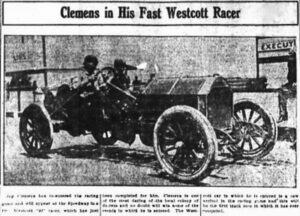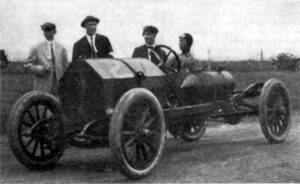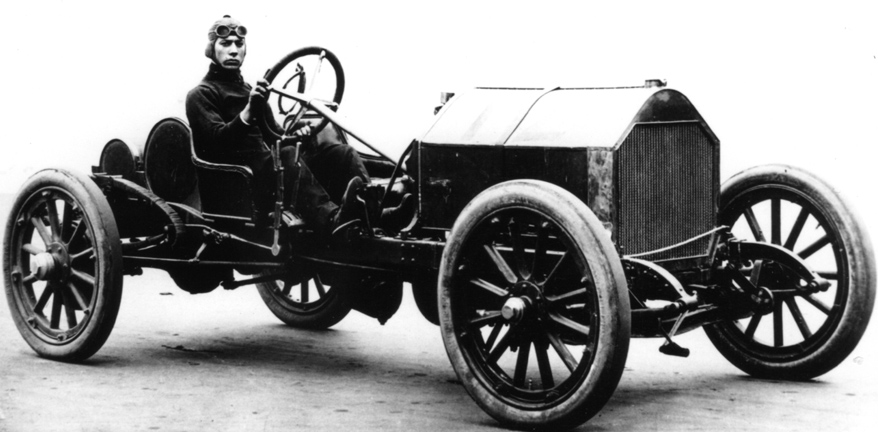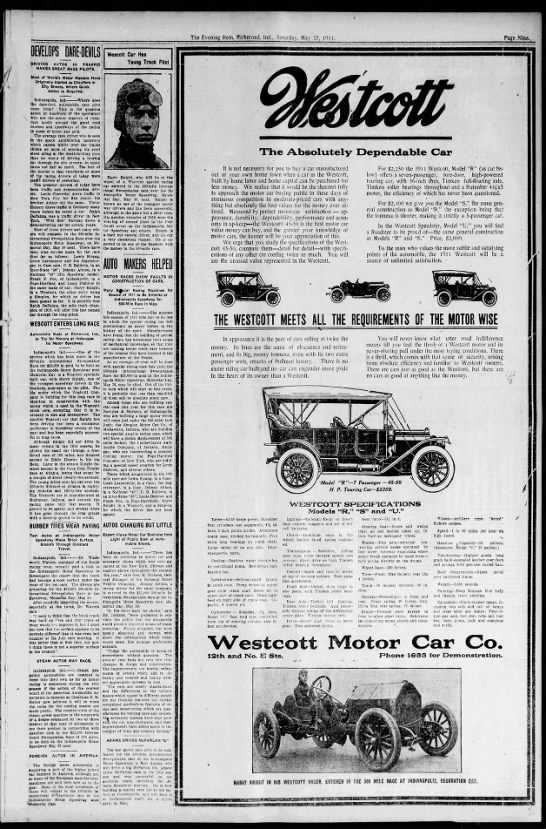The Westcott Motor Car Company had a brief but spectacular foray into auto racing starting in 1910 and ending by setting the story line for the inaugural Indianapolis 500 on May 30, 1911, after which the company shifted its value proposition from speed and power to reliability and luxury.
1910: Finding the Right Driver
Over the Memorial Day Weekend in 1910, the Indianapolis Motor Speedway, then in its second year of operation, featured a two-and-a-half-mile oval track, a new half-mile long viewing stand, and a series of races including a 200-mile main event to determine a “National Champion.” For its entry, Westcott recruited Fred W. “Jap” Clemens, a fearless driver known by fans for his skill in endurance races and by local police for his off-track crashes.
 Fred W. “Jap” Clemens drove a Westcott at the Indianapolis Motor Speedway on Memorial Day Weekend in 1910 |
 For the 1910 Labor Day Weekend races at Indianapolis, the Westcott Motor Car Company went with a relative unknown, 22-year-old Harry Knight, It was a good move. Knight’s tenacious driving helped prove the Westcott claim of durability and reliability. |
The Indianapolis Sun ran a picture of Clemens in its race preview with this caption: “Jap Clemens re-entered the racing game and will appear at the Speedway in a new Westcott ‘40’ racer, which has just been completed for him. Clemens is one of the most daring of the local colony of drivers and no doubt will win some of the events in which he is entered. The Westcott car in which he is entered is a new arrival in the racing game and this will be the first track race in which it has ever competed.”
In the main event, 200 Miles in 80 Laps won by Ray Harroun driving a Marmon car, Clemens finished out of the money (eighth) driving a “Wescott.”
The 1910 Speedway season ended on the Labor Day Weekend with another series of races. The Westcott Motor Car Company returned to the oval track with a new car and a new driver, 20-year-old Harry Knight. The youngster from Indianapolis did not disappoint. The Westcott entry finished second in the main event, a lap behind Eddie Hearne driving a Benz in the 100-mile Free-for-All. But according to the Palladium-Item, the hometown newspaper for the Westcott Motor Car Company, Knight and the Westcott put in a remarkable non-stop performance, proving the Westcott’s mettle.
RICHMOND MACHINE MAKES FINE RACE
Driven by Unknown Young Driver, Westcott Car Second in 100 Mile Event.
NOT ONE STOP WAS MADE
This feat was only equalled once before on Indianapolis speedway
track—driver sets an ovation.
(Palladium special)The Westcott car made in Richmond, driven by Harry Knight, just turned of age. ran the most consistent 100 mile race that has ever been driven on the speedway track. The Westcott took second place in the event, pushing Eddie Hearne in his famous Benz every lap of the distance. For a young driver stacking up against the real thing in the motor racing game for the first time, Knight’s performance is looked upon as little less than a marvel.
He kept his car to the track for lap after lap never stopping once, a feat that has not been equaled upon the Indianapolis track since last May, when Ray Harroun in margin negotiated the same distance without a stop. Prior to Harroun’s performance nothing of the kind had ever before been accomplished. Knight placed both himself and his car in top-most position.
1911: Knight and the Westcott are Once Again the Story
Buoyed by the Labor Day success, the Westcott Car Company again tapped Harry Knight to drive, this time for the first 500-mile race at the Indianapolis Motor Speedway, on May 30,1911.

 In the run-up to the race the company ran a four-column ad —Westcott, The Absolutely Dependable Car — in the Richmond Evening Item (May 27) adjacent to a race preview featuring (surprise, surprise) the young Harry Knight:
In the run-up to the race the company ran a four-column ad —Westcott, The Absolutely Dependable Car — in the Richmond Evening Item (May 27) adjacent to a race preview featuring (surprise, surprise) the young Harry Knight:
WESCOTT ENTERS LONG RACE
Automobile Made at Richmond, Ind., to Try for Honors at Indianapolis Motor Speedway
One of the entries which has been made in the 500-mile International Sweepstakes Race for $25,000 in gold, to be held on the Indianapolis Motor Speedway next Memorial Day, is a Westcott specially built car, with Harry Knight, one of the youngest speedway drivers in the business, nominated as the pilot. The big motor which the Westcott Company is building for this long race is identical in construction with the motor which is used in the Westcott stock cars, excepting that it is increased in size and horsepower. The smaller Westcott car that Knight has been driving has been a consistent performer in Speedway events of the past and has been especially successful in long races. Although Knight did not drive in many events in the 1910 season, he piloted his small car through a free-for-all race of 100 miles, and finished second to Eddie Hearne in his big Benz. Later in the season Knight finished second in the Coca Cola Trophy race at Atlanta, losing that event by a margin of about twenty-two seconds. The young driver sent his car over the 100-mile distance at Atlanta in eighty-six minutes and thirty-two seconds. The Westcott car is manufactured at Richmond, Indiana, and entered the racing fame only last season. It proved to be speedy and several times it has gone through the long grinds with a nonstop record to its credit.
The following Tuesday Ray Harroun driving the Marmon “Wasp” won the first Indianapolis 500 after 200 laps and 6 hours, 42 minutes and 8 seconds. Harry Knight was in third place chasing Harroun at 80 miles per hour when he swerved to avoid running over a “mechanician” who had fallen out of his car and crashed the Westcott in the pit area.
Writer Steve Martin retold the story of Harry Knight’s heroics and the end of auto racing for the Westcott Motor Car Company in the May 24, 2010 Palladium Item:
Our Past: Quick thinking saves life at Indy 500
At the very first Indianapolis 500 race, a courageous man driving a Richmond-made car won the hearts of more than 80,000 fans and stole the headlines from the winner. The first race was held at the Indianapolis Motor Speedway on Memorial Day, May 30, 1911. To qualify, entrants had to maintain speeds of at last 75 mph for more than a quarter mile. The first race ever was a spellbinder and a testament of human courage and sacrifice.
Ray Harroun — piloting a Marmon “Wasp” outfitted with his “newfangled” invention, a rear-view mirror — raced to victory, but it was a man driving a Wayne County-made car that won the hearts of the spectators paying a dollar a piece to witness the competition.
The driver of the Richmond-made Westcott was a young man named Harry Knight, who had won the hand of a beautiful Hungarian dancer named Jennie Dollie. Their nuptials were contingent on Knight winning big money at the race. He didn’t. He wrecked.
The Indianapolis headline read: “HARRY KNIGHT, IN A RICHMOND WESTCOTT, PURPOSELY WRECKS CAR TO PREVENT KILLING A MAN.”
The unthinkable occurred 196 laps into the race.
Knight was in third place and gaining, when another car left the pits with a broken steering knuckle. The unwieldy machine swerved out of control, then careened off a cement wall, wobbling to the middle of the congested track.
According to the Richmond Palladium, “A half dozen thundering machines bore down upon it.”
To avoid a smash-up, mechanic Charlie L. Anderson jumped from the sidelines toward the car to shove the crippled machine back to the wall. As he jumped onto the track, a rear wheel passed over his foot and he was thrown flat on his back in front of speeding racers.
The news story went on: “If ever a man was within a hair’s breath of eternity without going across, Charlie Anderson has that distinction. Nothing in the history of the auto race game approaches the situation… Lying there in the midst of 40 machines passing the spot two seconds apart at more than 70 miles an hour, it seemed that Charlie’s time had come.
“At the prospect of seeing a man mangled alive and ground to death, the crowd arose and waited in horror…
“Starter Fred Wagner ran onto the course and vainly sought to stop the race. The riders couldn’t stop, and two of them swerved aside miraculously, without hitting Anderson or the stranded car. Two more cars passed… It happened so quick it was over before anyone realized what had occurred.
“Then Harry Knight was next… The Richmond Westcott sped along at almost eighty miles an hour, with Knight and mechanic John Glover inside. Knight saw Anderson in his path… Thundering along at break-neck speed, two courses of action were open to Knight as a prostrate man sprawled helplessly on the ground directly before him — he could hold the car straight and run over Anderson — or he could purposely crash by swerving to the pits to his right, with just a slight chance of escaping death or severe injury.
“While spectators stood in the grandstand with bated breath, and gazed horrified at the scene, where in the twinkling of an eye a snap decision had to be made or some horrible catastrophe would surely result… the 22-year-old Knight made his decision the instant the situation confronted him, and yanked his car toward the pits, at the same time jamming his emergency brake to stop.
“Instantly applying the emergency brakes at this speed, at the risk of his life, Knight caused the machine to perform one of the strangest pirouettes in auto history. The sharp turn made his car slide on the oily track. Burning rubber created a smoky vista as it skidded entirely around, facing the opposite direction… The pent-up speed, the terrifying momentum checked by the sudden skid and whirl, broke it loose from the pavement and the car launched airborne, as if shot from a canon, striking the stalled car in the rear and hurtling over it… The now-flying Westcott clipped the broken car and turned it completely over, knocking it toward the pit, from which four men scrambled out for their lives…
“The impact of both racers caused the mechanic in the Richmond Westcott, John Glover, to be hurled about 20 feet in the air. He landed beyond the pits in a muddy pool, with a wrenched back.
“Knight clung to the wheel until the car smashed into the grounds… then was thrown like a rag-doll out the side.”
The Westcott smashed up against a post, completely wrecked.
Knight suffered a severe brain concussion and bruises. The first words he cried, “I didn’t hit him, I didn’t hit him!”
Many witnesses thought had it not been for the accident, the youthful driver of the Richmond car might have won.
“By his choice of risking his life rather than to take that of a prostrate comrade, Harry Knight forfeited his chance of winning the race, or at of least placing his Richmond car at the finish. He was in third place when the accident happened, and running well up with the leaders.”
The 22-year-old Knight won more adulation than the race winner.
His heroism was described in detail by national news outlets. Bulletins of his condition as he recovered were issued hourly from Indianapolis Methodist Hospital. He later was recommended for the hero’s medal presented by the Carnegie Hero Commission because “he sacrificed fame and glory” as race leader and wrecked his car to avoid killing another man.
There was an additional cost, though, as Knight now could not marry the Hungarian dancer to which he was betrothed.
Sadly, the young man dubbed the “hero of Indianapolis” tragically lost his life two years later, at the age of 24, in a Columbus, Ohio, 200-mile dirt track race.
It is not known if he was married at the time.
© 2021 www.pal-item.com. All rights reserved.
Sources:
Betty Westcott Acker, Westcott Motor Car, self-published in 1996.
Newspapers.com for Richmond, Indiana Palladium-Item
A Visitor’s Guide to Indianapolis and the Indianapolis Motor Speedway
